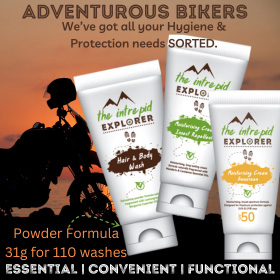 134Likes 134Likes
 |
|

6 Apr 2014
|
 |
Registered Users
Veteran HUBBer
|
|
Join Date: Nov 2010
Location: Santa Cruz, California
Posts: 316
|
|
|
Straight Up Togo
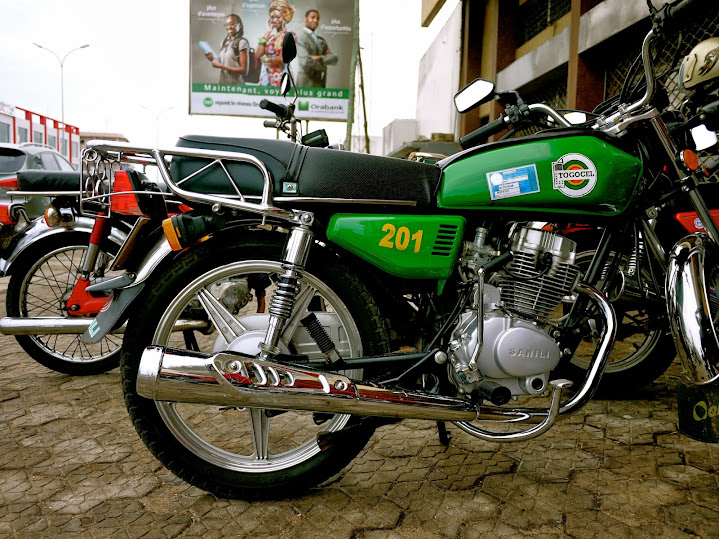
Arrival in Lome, Togo landed me back into a maelstrom of motorbikes on the road.  It occurred to me that the reason motorbikes generally didn’t follow any rules in Accra was because there were so few of them cruising the streets. In Lome, with so many bikes about, it would create a lot more chaos if everyone were blowing through red lights. There was something very comforting about being back in a sea of motorbikes – surrounded by my African two wheeled brethren!

In Lome I sought visas for Benin, Republic of Congo, and Gabon. On arrival at the Gabon embassy, they wouldn’t let me enter wearing shorts. Mind you, the temperature was 98 degrees F with 70% humidity. Since the visa window was to close within 20 minutes, I raced off to the local marketplace for a very quick shopping trip. I returned wearing the cheapest pair of pants that I could find in the 5 minutes that I had to look. They were very colorful and I looked ridiculous. On leaving the Gabon embassy in my festive pants, I made a momentary wrong turn into a street that led to a military facility of some kind. There was no sign and I had just gone about 20 feet from the intersection before I tried to turn around, but of course the military guys who happened to be on the corner ordered me to stop, demanded my documents, and detained me for an hour. The delay caused me to miss the morning visa submission for Benin, which would keep me in Lome over the weekend. Thanks guys. Must have been the colorful pants that made them so suspicious.
The new tires that I’d mounted in Accra (Continental TKC80s) started with the usual squirmy new tire feel, but quickly wore in and felt far better than the Mefo Explorers that I’d had been running up to now. Hopefully this set will make it all the way to Cape Town since there is nowhere in between to get tires. Getting this set from another traveller who’d had them shipped to Accra was no more than a stroke of luck.
In Lome I joined Mikayla who I’d met in Cape Coast, Ghana. She had been living in Lome for a few months already and she and her roommate Sylvie took it upon themselves to show me some of what the city had to offer. Mikayla hopped on the back of my bike and we sped around the city to find restaurants, bars, and beaches.
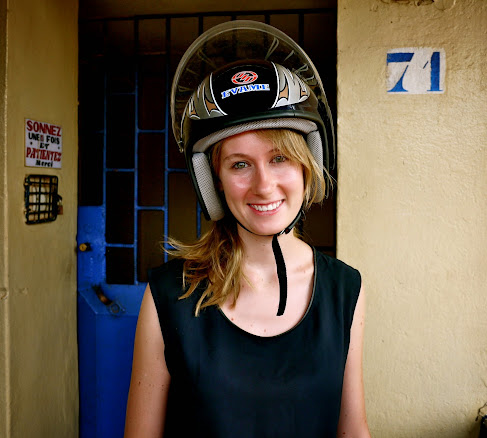
Near the Benin embassy I found a guy to repair my seat, which had blown a seam due to abrasion from my boot when I hopped on from the high side (since the surfboard was mounted on the low side).
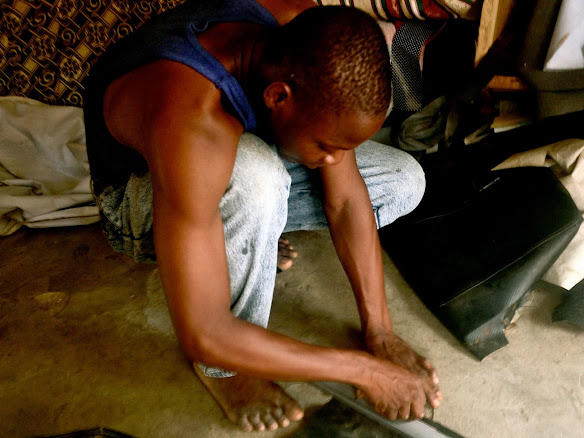

By the end of the week, my passport was tanked up with visas and I was ready to roll. Unfortunately, Dyna Rae was not. Just outside of Lome she began to stumble occasionally. I’d felt the same issue back in Ivory Coast and had used the tried and true approach of ‘ignore it and hope it goes away’, which had worked fantastically well up to now. After riding some distance, her stumbles became bad enough that I decided to pull over so that we could discuss what the problem was. It seemed as though she was having trouble breathing, so I cleaned and re-oiled the air filter as best I could along the roadside and had a look inside the top of the carburetor. The entire time that I was tinkering away a woman working at a nearby toll both was trying to convince me to give her my phone number so that I could meet her sister. I had trouble making her understand that I was only passing through and wouldn’t be here at all if I hadn’t broken down and I would never be here again as soon as I could get moving. Dyna’s problem improved somewhat, but it was still evident that she was very irritated about something. I had a long ride ahead, so I just carried on and tried to ignore her complaints.

I spent the day riding the wrong direction: straight north along the entire length of Togo. The next day I was happy to make the turn eastward and I burned across Benin on excellent roads,entering and exiting the country within just 5 hours. Oddly enough with such a well-maintained road, I didn’t find a single petrol station on the traverse. In Togo it seemed that there were petrol stations on practically every corner. It reminded me not to rely too strongly on assumptions for what lies ahead.
Upon entering Nigeria, the road disintegrated completely. It turned into my least favorite kind of dirt to ride: a narrow, grooved track filled with about 6 inches of sand. The hard sides of the grooves seemed to continually knock your front wheel sideways to start it plowing forward and have you jump out to the groove where the sand was deeper. Local guys on 125cc bikes flew past me smooth as could be and I told myself that it was because their bikes had narrower tires, running lower pressures and were unloaded. But I honestly fear that I just can’t seem to figure out how to ride in this stuff.

Since crossing into Nigeria, military and police checkpoints resumed that had been nearly absent in Togo and Benin. Some were legitimate and some were not. I’d read about the Nigerian ‘Stick Men’ who stand at the roadside laying spiked barriers across the way to demand money from travelers and truckers. Part of the reason for taking a route through the middle of Nigeria via Abijan is that these characters and other lawless folk are more prevalent and aggressive in the south of the country. My route seemed to be a good choice as all I encountered were friendly people. At every village smiling kids ran towards the road as I passed shouting 'Oyibo! Oyibo!' which is the Nigerian word for a white person. Even the Stick Men were nice let me take their photo.

I was trying to make it to a village called Kaima, but soon found that was a terribly optimistic target given the road condition. As night fell I turned off of the dirt track to find a campsite amongst the giant termite mounds that dotted the forest floor. The ground was flat, solid, and free of low brush so it was easy to ride into the trees and out of sight without even a trail. Unfortunately I’d lost a water bottle during the journey along the bumpy road and had been sweating like crazy moving slowly in the dirt. That night I learned that trying to go to sleep thirsty is a lot less fun than trying to go to sleep hungry. I had to focus to stop dreaming of a giant glass of iced tea or a bottle of Gatorade straight out of a California gas station refrigerator. As I lay sweating in my tent my thirst grew and eventually I became so desperate that I climbed out to suck out the few drops of water still trapped in my water filter. I swear that I nearly packed up and motored to one of puddles I’d seen on the road to suck some water through my filter.
Since my tent was broken, I’d rigged the rain fly to press against the tent body to keep insects out. It worked well for anything flying around, but the giant ants that prowled the forest floor were a different story. One after another, I would feel one crawling on me, I’d shoot up, click my headlight and punch them into the floor of the tent. As I lay there surrounded by ant corpses, swallowing against the dryness in my throat, and trying to slip into sleep, I wondered what in the world I was doing in the middle of Nigeria.
|

9 Apr 2014
|
 |
Registered Users
Veteran HUBBer
|
|
Join Date: Nov 2010
Location: Santa Cruz, California
Posts: 316
|
|
|
Spending it All in Abuja

As I sat at the Nigerian police station I wondered how in the world I’d managed to land myself in such a tight spot and when I would finally be able to go to sleep.  The day had started out well enough getting on the road at 6 AM and finding some water within an hours ride after a thirsty camp the night before. I knew that I was in for a long day, but as the road changed from dirt to broken tarmac and then some sections of good tarmac with less massive craters to weave around, I became hopeful about making it to Abuja before nightfall. If I’d know what the day had in store I may have simply stayed lying thirsty in my broken tent on the forest floor.
No one seemed to have anything good to say about Nigeria. The north is awash with rebel militias and stories abound from the south of aggressive bandit type folks stopping people on the road. Consensus amongst overlanders seemed to be that the safest path was to shoot straight through the middle, via Abuja. At one checkpoint a soldier asked me what I thought I was doing riding here on a motorbike alone. “Have you not heard of Boko Haram? Is it not safer to stay home?” he asked. I said that I supposed it was, but then I would have to see Africa only on television, which got a laugh from him. Boko Haram is an Islamist group with links to al-Shebab and al-Qaida, responsible for numerous bomb attacks and thousands killed over the last few years in Nigeria. The group is known for attacking Christians and government targets,bombing churches, attacking schools and police stations, and kidnapping western tourists [1]. I had believed their exploits were constrained to the north of the country, but I apparently I need to do my homework a bit better.

I rode 16 hours before reaching the outskirts of Abuja, long past nightfall. The last section of road before Abuja felt like the most dangerous thing I’d done on this entire trip. Taxi bus drivers hurtled through the darkness with no lights, dodging the deep road craters however they liked, no matter what was coming the other direction on the narrow road. In the dark, you barely see holes in the road and whatever random thing coming from the roadside before it is right in your path. I’m rather used to chaotic driving by now, but what I found myself in that night seemed like a reckless abandon of all sense whatsoever. As I looked down at my map, with the distance still to go to Abuja, my heart sank, knowing how long the previous stretch had taken.
I was elated when 20 miles outside Abuja, the road changed from that chaotic mess to a brand new, perfect modern three-lane freeway with very little traffic. I was flying. And then, as if that wasn’t enough, beautiful shining streetlights appeared over the road to light my way. I couldn’t believe it - I was home free. I had been riding for 16 hours, only stopping for gas and to pound a couple sodas. And now I was going to make it. I hooted loudly in my helmet.
Five miles from my exit the bike sputtered and died. She would start, but would die under any throttle. After a few desperate attempts it was clear that I wasn’t going anywhere quickly. I put the bike on the stand, leaned against it and put my head down. I’d spent everything I’d had and hardly had anything left to care about what was wrong with my bike. I was at the roadside in the dark in the middle of a Nigerian city. This was exactly the kind of exactly the type of exposed situation that I wanted to avoid. I let the whole scene of the road blur out in front of me and shut my eyes. I just wanted to sleep.
Then I got up. I started pushing my fully loaded bike up the mild grade ahead. There was simply nothing else to do. In Accra I’d met a guy named Bill who lived in Abuja and invited me to crash at his place when I arrived. His house was only about 5 miles away, but it was uphill and I didn’t know the best route to get there. Sweat streamed off of my face, and the last of my water was gone before I made it a mile. After two miles I could see the grade steepen ahead and decided that I would need to figure something else out.
While looking for some bushes to hide in by the side of the road I found 6 young guys sitting on their motorbikes and convinced one of them to give me a tow. Neither of us had ever towed a bike before and the first attempt nearly ended in disaster. Eventually we figured it out with me doing a lot of shouting "slowly, slowly!" I was moving again. Slowly, but there wasn't far left to go. Maybe this was really going to work out OK. I dreamed that Bill had a cold  waiting for me. Then the police showed up.
They officer demanded that we come to the police station with him which first involved towing my bike the wrong way down an off ramp straight into oncoming traffic. It was an incredibly stupid thing to do, with cars swerving to avoid us at the last second. But he was the one with the gun, so we did what this moron ordered. Once at the station, the officer explained to me how that I had committed very serious offence and that I was in quite a lot of trouble. Mind you this is a place where you regularly see people riding on the highway sitting on the roofs of cars. They put on a show of concern that I was who I said I was and going where I said I was going. They insisted that we call my friend Bill to vouch for me. Even with Bill’s diplomatic status as a US AID worker and a confirmation that his place was indeed where I was headed, there were plenty of other reasons manufactured that I should be detained. I tried the usual approach of contritely acknowledging my wrongdoing and offering that perhaps I could simply pay the ‘fine’ and be on my way, but to no avail. There were 8 officers in the police compound that night and it seemed that I was to be the entertainment for the evening.
After 3 hours with the police going round and round in circles trying to figure out what in the world these guys really wanted I nearly lost my cool. It was past midnight and I was exhausted and very thirsty. Finally I let them know that we could either figure this out in the next 10 minutes or I was going to go curl up right next to my bike in the police compound and pass out. They finally released me on the condition that I had a police escort to where I was headed. I arrived at my destination at nearly 1 AM along with my policeman friend who now had his hand out for payment of the escort that he’d provided me. My day was finished. I was incredibly grateful to Bill and his family for the hospitality they extended to me as I arrived late at night looking like a bum with the police in tow.
The next day I got to work fixing the bike. After a thorough carburetor and air filter cleaning she fired right up and pulled strong as I rode around the block. I congratulated myself on a job well done and went back to enjoying some air-conditioned socializing with Bill’s family and friends who all seemed to have interesting paths that brought them to Abuja.

Nigeria is a wild place to be working as an expat. Nearly the entire economy is based on oil revenues and the system is so corrupt that hardly any of those proceeds get where they are supposed to and mostly end up a long series of official’s pockets. The US government has a massive AID mission in Nigeria, but the corruption endemic to the existing power structure makes it difficult to gain traction on the most important problems.
Security is an ever-present concern for the workers as foreigners are often the targets of attacks or kidnappings by characters like Boka Haram. One morning we were set to leave for the park, but were stopped by the security guard as he listened intently to his radio. A few blocks away, a crew of Boko Haram had tried to bust a few of their homeboys out of prison, which resulted in a shootout. Before it was over, 20 Boko Haram suspects lay dead. I was having a much nicer time in Abuja than might be expected from reading the news.

Monday morning I loaded up my gear to get moving, but when I tried to start the bike there was no happy thumping Dyna’s single cylinder. After reluctantly unloading everything to get to the engine, a spritz of carburetor cleaner carburetor at the air inlet gave her the kick she needed and I was on the road again, but not for long. Before I’d gone 10 miles she started stumbling again, killed, and wouldn’t restart. I really didn’t feel like taking my bike apart again in the street, but few other options presented themselves. I found some fuel in the airbox and the carburetor full of gas up to the overflow leading me to believe that I had a problem in the float bowl of the carb. On the last disassembly I had replaced the o-rings of the float, but not the float needle which blocks further gas flow into the carb after it has reached the correct height. I took the float apart and replaced the needle with a fresh one, although the existing one looked fine to me, and checked the float height. I put the bike back together and she started but still ran like crap. Since it was already 3 in the afternoon at that stage, I decided that a retreat to Bill’s place was the most prudent course.
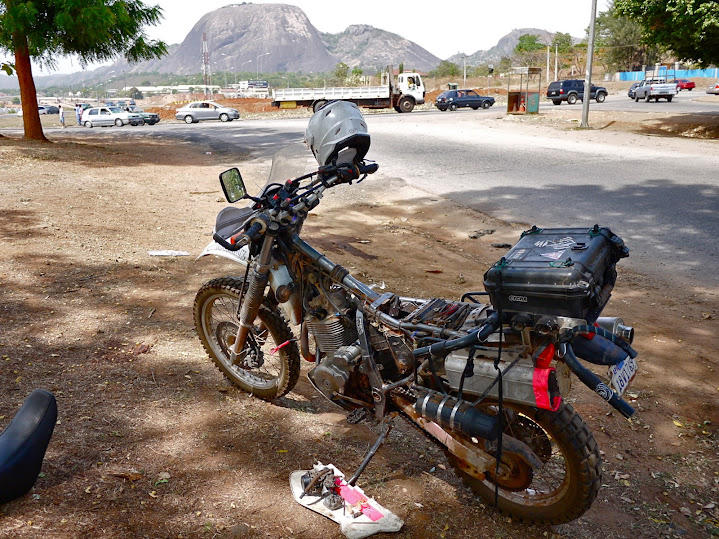

I couldn’t believe that after 4 times disassembling the carburetor I still hadn’t managed to fix the problem. There were only so many things that could be wrong! I felt inept and my gumption was sapped. I checked for vacuuming in the tank, verified that fuel was flowing from the petcock, looked for a vacuum leak at the carb, looked for loose wire connections, used a clear hose connected to the float drain to determine that the float was indeed shutting off fuel at the correct height, and I had already checked for compression and for a strong spark on the last go-around. Spark. Oops, I had spark, maybe I no longer did.
When I removed the spark plugs the next morning I found that they were absolutely caked with black carbon. As it turned out I had probably solved my initial clogged jet problem on the first try, but reinstalled the float carelessly so that it hung up and wasn’t shutting off fuel flow. The 20 or so miles that I had run with the float stuck created a super-rich condition, and the black as soot plugs turned out the be the new running problem with very similar symptoms to a clogged jet. A good cleaning of the plugs and I was good to go. My head had been so stuck in the groove of a carburetor problem and I was so ready to believe that I’d failed to solve it that I failed to see the simple solution. A silly mistake, but I was happy to have it solved.
I had shown up late at night looking like a criminal to the door of a guy who I’d met only once before. As I failed fixing my motorbike day after day I felt as though I was wearing out an already undeserved welcome, but Bill and his wife Ida just kept helping and telling me not to worry about it. I had a safe place to sleep while I sorted out my bike and Ida pretty much fed me three meals a day. Bill and I drank  s on the back porch and solved the problems of the world while his three boys ran around finding trouble to get into. Again and again on this trip I’m met with kindness from strangers when I need it most. It inspires a state of gratitude that I get to carry along with me for the miles ahead.
State of gratitude or not I absolutely hate how people drive in Nigeria. It’s a maddening mix of aggressiveness, unawareness of surroundings, and lack for regard for consequences. The evidence presents itself frequently enough as semi truck and busses smashed to oblivion on the side of the road. During the 11 hour ride from Abuja to the Cameroon border I was run off the road 4 times by oncoming trucks occupying my lane either passing someone or avoiding potholes. Once was on a blind corner, but the others were straightaways. They could see me coming a quarter-mile away and just didn’t give a shit. Getting out of the way was my problem. One of these instances I had to jump off the road into sand and loose rock at about 45 mph and could easily have crashed. That time it was a police truck that forced me off the road. Can’t say that my stay has made me a fan of Nigerian police overall as they seem to be either arresting me, asking for money, or trying to get me killed in traffic.
Leaving Abuja I stopped for fuel more frequently because stations were often out of gas or had massive lines to contend with. Ironic that the people of a country with nearly all of its revenue from oil have to endure fuel shortages with regularity.

As usual I drew a crowd at every stop. The demeanor of the Nigerians I encountered could best be described as aggressively friendly.
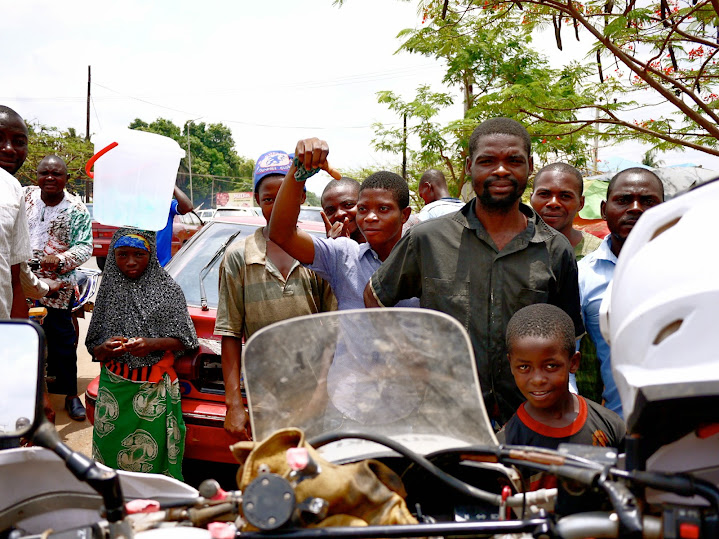
As I approached Cameroon, the landscape became lush and hilly and I was happy for a change of scenery.

|

15 Apr 2014
|
 |
Registered Users
Veteran HUBBer
|
|
Join Date: Nov 2010
Location: Santa Cruz, California
Posts: 316
|
|
|
Help Appears in Cameroon

I crossed the border into Cameroon at dark after 11 hours ride from Abuja and collapsed in an oven-like flea infested room.  I didn’t care and passed out almost immediately. But I do think that I have fleas now. The guys at this small border crossing were friendly as could be and made the end of the day a piece of cake.


The road near the border with Nigeria was rumored to be very difficult, especially in the wet season. Fortunately for me, we are right on the edge of the wet season and the roads are still in decent shape. The roads are currently being graded, most sections are pretty good, and soon enough the trip from the Nigerian border should be smooth as can be.


As I rode into the Bamenda Highlands of Northern Cameroon I felt wonderful cool air rushing past my face for the first time in months. I wound up a steep valley with an opposite wall of dark sheer cliffs with vines running down them and topped by lush vegetation. The never-ending bends, sparse traffic, and perfect tarmac made it difficult to resist laying the bike over hard through the bends on the throttle, scraping away precious millimeters of rubber on the tires that had to make it all the way to Cape Town. The steep jungle valleys and crisp air reminded me of a miniature version of the Andes.
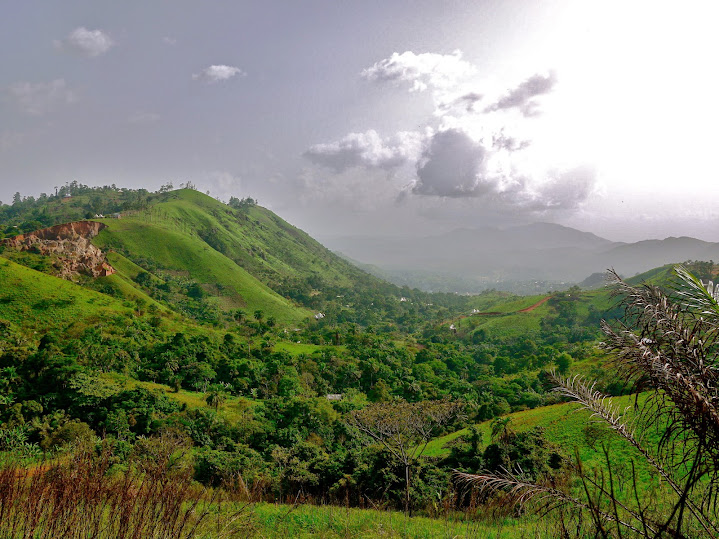



I had a bit too much fun on one of the bumpy sections of road and managed to break my surf rack again. This time the rear arm of tubular aluminum snapped right off.

I rigged up a surfboard belay anchor to get me down the mountain.

I simply wandered down the street in the random little village that I slept in the night before and didn’t have to go far before I found someone to help. With my metal working savior, James, I carried a relic of a pipe bender out from a garage and he and his crew got to work fashioning me a new arm for my surfboard rack from piece of tubular steel.


The entire operation required some bending, cutting and welding to make a bend that was tight enough without collapsing the tube. Get a load of his welder:

And viola - a new handmade surfboard rack!

All of this was done right in the front of his house with the whole family milling about.

The chicken just chilled in the house.
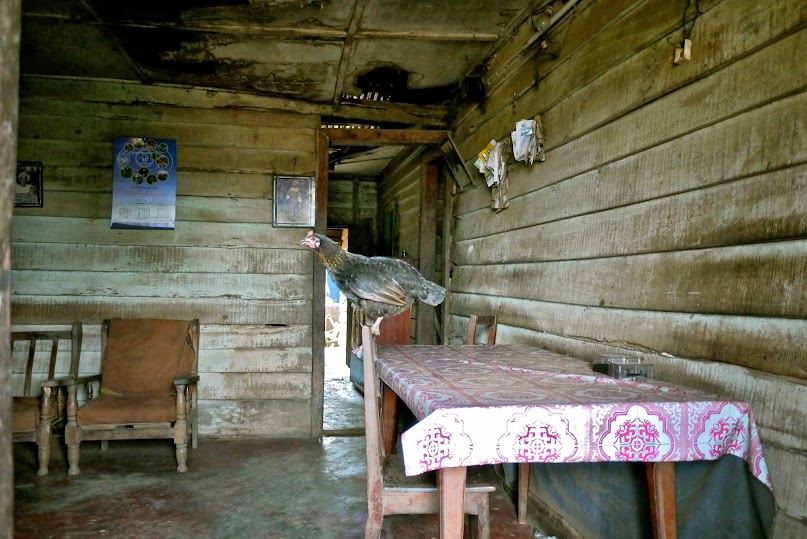
They use to most primitive of tools and materials that are on hand to make things work. Back home in the US you could imagine someone saying that the problem simply couldn’t be solved, but here these guys use ingenuity and persistence to the job done. I watched James spend hours trying to extract a bolt from my rack that was frozen in place and had the head snapped off. He must have welded a rod onto it to try to turn it more than a dozen times before he finally managed it.

The shop crew all ride motorbikes too.

But they weren’t really fans of airboxes.

After spending nearly the entire day at his house I bid farewell to James and his family with my surfboard again solidly attached to my bike and rode out to the coast. Once again, I’d quickly found help when I needed it most – with my poor surfboard swinging in the wind. Days like this make it feel as though when you’re chasing after something worthwhile the universe truly can conspire to make it happen. Maybe it’s just easy to perceive it that way. Or maybe there is little difference between the two ;-)
Just before dark I found a nice reef break peeling across a tight little bay filled with dark brown volcanic sand. My view from the water was the volcanic cone of Mount Cameroon that towered just behind my camp, ringed in wispy clouds.
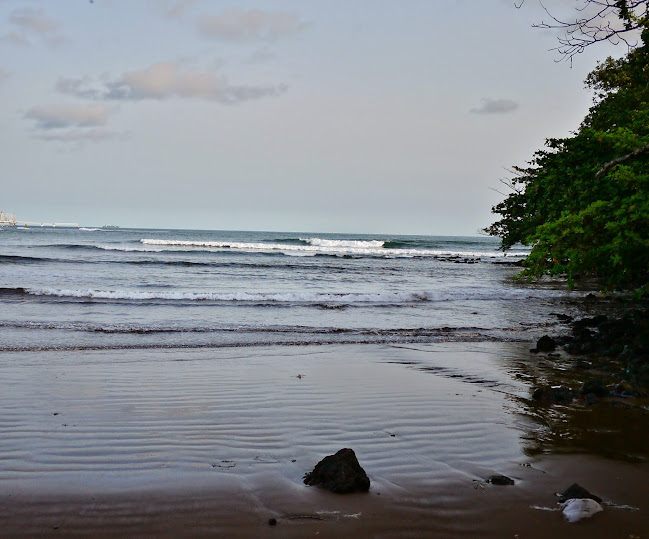
The next morning I surfed until lightening strikes near the horizon chased me out of the water and motored south to find another wave and another camp for the night. As usual, I arrived after a day of riding with my face caked in diesel dust, looking like a character straight out of a ‘Road Warrior’ movie.

And as usual I receive a friendly greeting, offer of a cold  and a gorgeous spot on the beach to pitch my camp and rest. Life could be worse.

At my next surf stop I met the local surfer, Peggy. By all accounts, he is the only surfer in all Cameroon, surfing here since 1994, when his boss brought him a surfboard from France. Since then, his surfboard collection has grown substantially, but company in the water has not. Unfortunately - the ocean provided no waves for Peggy and I to trade.
Leaving Cameroon, I found a gorgeous undulating dirt track leading me towards the Gabon border. No trucks running me off the road, no massive tarmac craters, and no diesel dust collecting on my face. The short rains from the previous nights had put just enough moisture in the ground to make the dirt nice and tacky - perfect for railing around corners with a confident feeling about the friction between the rubber of your tires and the surface below. It was the most fun I'd had riding in months and I was stoked to have a long dirt track and nothing to do all day but ride. It's the start of the rainy season in this part of the world and I wanted to make some progress south before the Congo turns into a proper mud pit, so I kept on the gas.
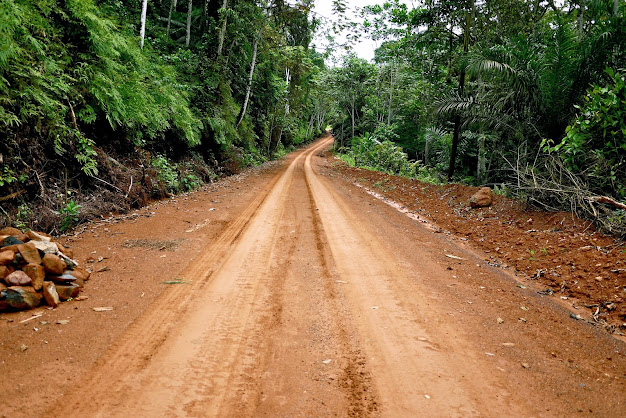
|

23 Apr 2014
|
 |
Registered Users
Veteran HUBBer
|
|
Join Date: Nov 2010
Location: Santa Cruz, California
Posts: 316
|
|
|
Surfing Hippos and Other Equatorial Legends

In 2004 National Geographic ran a story about a national park in Gabon with what they called ‘surfing hippos’ that make their way right into the surf zone from the adjacent estuary. I’m not sure there’s a better way to enliven the imagination of an adventurer in Africa.  More recently, there have been reports from surfers of reeling left-hand barrels in the same area. Like surfing hippos, some things have to be seen firsthand to believe. A perfect ribbon of virgin tarmac stretched out in front of me as I swung the bike over from one side to another through the curves. Along the sides of the road, the vegetation was neatly trimmed for 20 feet away from the tarmac. Charming villages with lined the sides of the road with children smiling and waving as I passed. There was hardly any traffic on the road as I headed south from the border with Cameroon. There was no trash by the road. The temperature was cool. I’d somehow found this perfect riding scenario embedded in my usual African riding experience that includes feeling like a blow drying is blasting in your face all day, dodging massive square edged craters, and being hunted by truck drivers. 
I rode about 10 hours each of the next 2 days, making quick work of the road through Gabon. It was fun riding and it flew by as I rode in a relaxed, nearly meditative state. I crossed the equator just north of Libreville and soon after, Dyna Rae turned 30. I told her that she didn’t look a day over 20 thousand.

A cloud burst forced us to hole up under a church roof until the squall passed. Fortunately, church was not in session.

The reason that there are hardly any people on the road is because hardly any people live in Gabon - only 1.5 million in the entire country. Compare that to Nigeria with 170 million or Ghana which is similar size to Gabon, but with 25 million people. For the first time since I was in the Sahara desert, there was wilderness without people. I saw untouched hills and clear rocky streams that weren’t crowded with people doing their washing. It all reminded me a bit of being back home in California on a road trip into the backcountry. Finding a spot to wild camp in Gabon would be a breeze. On the afternoon of the second day, my pace slowed somewhat when the tarmac dissolved into red earth. It looked like an endless track into the clouds.

Gabon is hard at work changing some of the bumpy dirt sections of the main roads to tarmac, and they aren’t doing a halfway job of it; with massive terraced hillsides lurking around several corners in the work zones.

Heading out to the coast, the dirt road became ungraded and strewn with rills and ruts that creates and incredibly rough riding surface. The clay rich soils dry into sequences of these undulations perpendicular to the road as solid as cement.
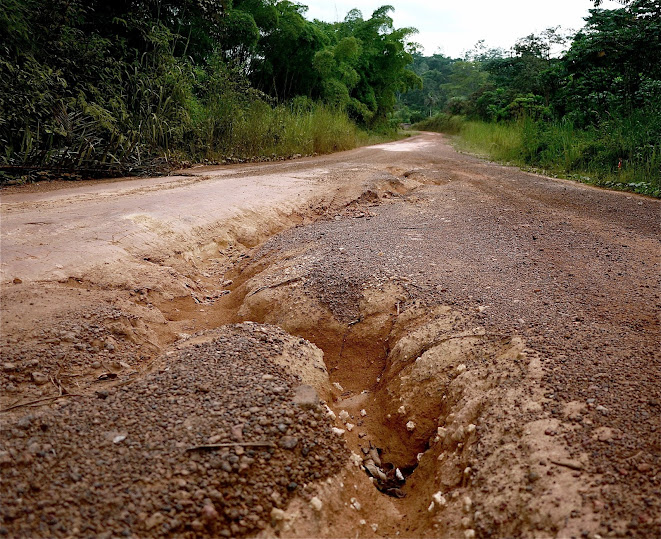
In addition to hacking up the road, the recent rains had swollen the rivers to engulf the treetops.

You have to wonder whether what you’re getting yourself into when the roads disappear.

On the map I saw that I was approaching a large inlet and had no idea how I was going to get to the other side. I imagined that it was going to be something difficult and long. As I approached the inlet I couldn’t believe when I saw a massive modern bridge spanning the water and it was nearly complete. This bridge was a total divergence from what I’d been traveling on the last 3 hours and simply didn’t make any sense to be there at all. I later learned that this place is to be one of the largest shipping ports in West Africa; with waters deep enough to host even the largest container ships. The road to the interior of the country is being built to transport goods to and from the ships. All of this building and the perfect roads that I’d enjoyed nearly the entire way across the country are the result of the usual agent of prosperity in African countries: oil. As it turns out, Gabon has plenty of it.

I heard a shout as I motored out onto the bridge. Apparently it wasn’t quite finished yet. So unless I fancied getting Evil Knievel over the unfinished section I would have to take the floating road instead.
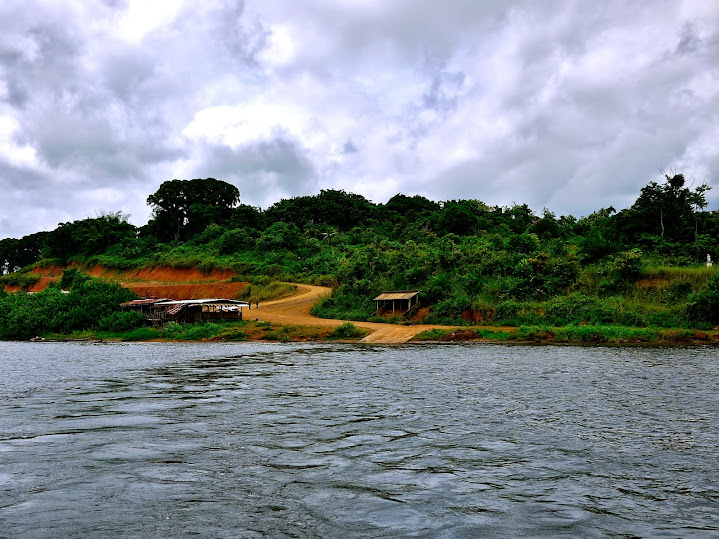
After nearly 8 hours of travel on rough dirt tracks, I arrived at a village on the coast. As usual, orientation upon arrival takes some time. It’s not like when you want to go visit a national park and can find that on the map and simply head that direction. I usually have a vague notion of where a surf break is and often end up doing a fair bit of looking around before I do anything else, since deciding where to stay usually has to do with where the surf is. Per my usual routine, I motored up to the beach, walked out and looked up and down the coast for a clue of where I should head. To my south I could see a prominent sand point with what looked to be left breaking waves peeling along it. That was good enough for me and I set off to find a way to access the coast nearer to where I’d seen the waves breaking. After a bit of looking and some help from local village folks I found an overgrown, barely visible pathway from a road into the brush A quarter mile mile walk through the brush dumped me onto sandy white beach, near the waves I’d spied from about 2 miles north. As I emerged from the tangle of branches and vines, I stood staring slack jawed at what was in front of me.

The setup was perfect. It was an overhead grinding freight train of a wave. It was difficult to pick the right one that let me in early enough and didn’t heave an giant unmakable section unloading in my path. But I got as many tries as I liked. Making one all the way to the end with a few good snaps along the way was cause for a loud howl on kicking out. There was no one to hear anyway.

It wasn’t quite the endless ruler edged perfection that I’d dreamed of during long hours on hot, rough, dusty roads, but legends do loom large in the imagination. The wave had power and speed a plenty and I could hardly complain having it all to myself for a few days. I was stoked. Never did get to drop in on a hippo though. Now that would have been legendary.


|

24 Apr 2014
|
|
Registered Users
HUBB regular
|
|
Join Date: Nov 2013
Location: Key West, Florida
Posts: 26
|
|
|
Great road report. Much fun to read. As silly as it sounds seeing all your fabulous pictures I love the shot of your speedometer. I can't remember the last time I saw a speedo in miles without kilometers inside cluttering up the dial...the things we notice! Please keep posting as, on a more serious note you are a great help keeping me going through the night at my desk.
|

28 Apr 2014
|
 |
Registered Users
Veteran HUBBer
|
|
Join Date: Nov 2010
Location: Santa Cruz, California
Posts: 316
|
|
|
Shelter in the Congo

I took a wrong turn getting back to the main road in Gabon and ended up riding in seven hours to cover what should have taken five by inadvertently back-tracking north.


The delay put me across the Republic of Congo border just about dark. When I asked the immigration official how long it was to Point Noir, my spirit sank when the answer came in days rather than hours. What I supposed might take me three to four hours to cover would take two days. I didn’t really believe him, until I got a little way along on and found a mud bog where a road once was. Being that I had no plan whatsoever, I just kept riding. I traversed a couple of 40 foot long mud puddles that swallowed my front wheel. With darkness closing, and a storm gathering I started to have that ‘what am I getting myself into’ feeling.
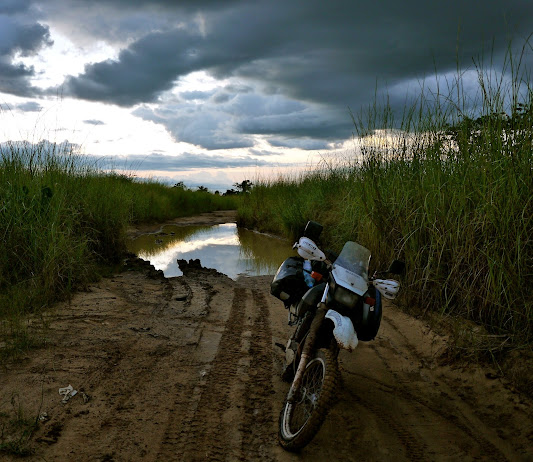
I passed a village composed of a score of mud brick homes, found the chief, and asked if it would be all right if I camped there for the night. They couldn’t have been more accommodating and let me set up my tent right underneath a little open-air covered area with a corrugated tin roof. A storm was quickly approaching and I was happy to have some shelter in addition to my broken tent. I slept restlessly. Every time I woke up with the rain still drumming away on the roof I thought of what it was doing to the road. I had a dream that I was stuck in a mud bog with hippos trying to eat me.

The trouble with these big, long puddles is that it’s difficult to gauge how deep they are. Never did I want more for some other riders as companions for when things went wrong. I walked the first couple big ones to check their depth, but there seemed to be an endless string of them, so I just started looking for tracks around them or just barged on through. A few put me headlight deep into the water. Escaping from the deepest one was not a terribly graceful affair. Dyna’s front end disappeared abruptly beneath the brown water and she revved high and slipped sideways trying to find her feet in the mud beneath. I dare say that a lesser bike wouldn’t have made it out of that one, but she pulled me though it but the skin of her gear teeth. After the giant puddles tapered off, the track became a giant muddy slip-and-slide. As soon as all the knobs of my tires packed up with mud, the slightest nudge of a rock or rut would send me sliding sideways. I’d overtopped my boots and filled them with water in one of the first puddles and spent the rest of the day with swampy feet. Again and again I hoped that made it through the worst of it but found no lasting reprieve until 80 miles of mud bog had been traversed. It took eight hours.



The feeling was nothing short of elation when I returned to graded, hard-packed gravelly goodness. It was bumpy as hell and filled with holes, but it felt great to have some traction under my tires again. As I bounced along at a good clip I felt pretty happy not to have my bike lying drowned in a giant puddle somewhere. I blazed ahead into the Congo sky.

I’d ridden twelve hours and was happy to find some friends when I arrived in Point Noire. I’d first met the two German couples traveling in 4x4’s with roof tents in the beach town of Kribi, Cameroon, where Marc approached with a friendly call of “Hello, you must be Gary!” I wasn’t terribly surprised that he knew who I was as the network of overland travelers up and down the west coast of Africa has by now all either met or heard of one another. I’m not hard to spot as the only guy on a motorbike with a surfboard. Our home in Point Noire was a shipyard amusingly referred to as a ‘yacht club’. The price of admission was no more than a couple  s to share with the security guys.



I paddled out the next morning at the main beach in sheet glass water with super fun shoulder high sandbar peaks curling all around me. I spent three days in Point Noir surfing the beachbreak, every day spying turtles poking their heads up at me in the surf like periscopes. Dyna Rae got some fresh oil and her from sprocket changed from a fifteen-tooth to a fourteen-tooth one, gearing her a bit lower, which should help in the mud.

Some other overlanders had reported back that the road to Luozi where I could cross the Congo River in the Democratic Republic of Congo (DRC), was very bad and maybe not passable when wet. We’d had a few dry days in Point Noir and I hoped that the same was true further east.
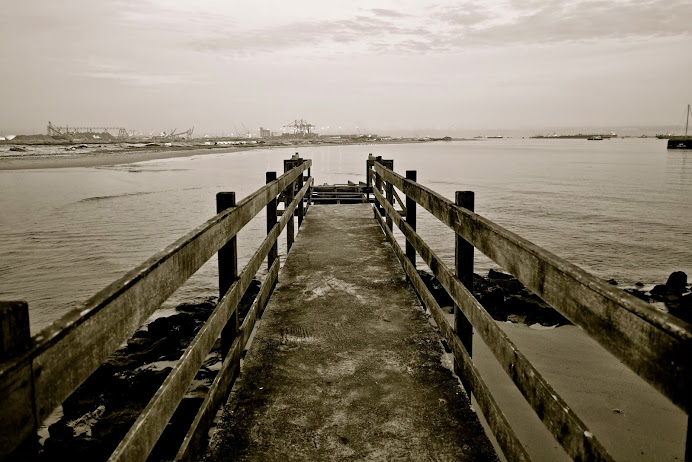
The other problem that we all were going to have to contend with was that there were reports of people being turned away at the DRC crossings at Kishasa and Boko because their visas weren’t issued in their country of residence. This is a requirement for the DRC visa and one of the reasons it’s so difficult to get on the road. You would think that you were all set after you’d convinced the guy at an embassy to give you a visa, but more and more immigration officials at the border were becoming savvy to this requirement not being met and turning travelers away. This was not a small problem as there is no way to get around the DRC, you simply have to go through it if you’re headed south overland. Unlike most problems at borders in Africa it would seem that even few bills to the right man in uniform didn’t make this one go away.
I rode all day from Point Noire to reach the village of Mindouli, where there was supposed to be a small border crossing into the DRC. Without a few people pointing me the right direction, I never would have found the way. I followed rutted tracks up hillsides and it looked like I was riding into the middle of wilderness. It was as rough of terrain as I’ve ever ridden, even unloaded. The rain from the night before had made the dirt slick enough that I quickly found myself sliding sideways straight into some deep ruts that I really didn’t want to be in. I got properly stuck twice and had to enlist the help of a local guy passing by to help get me out. It wasn’t far to the border with DRC, but it was very tough going and I didn’t earn any style points on the way.



Some places it was difficult to call this thing a road.

As Dyna revved high tracktoring up the last steep rutted slope I saw the flag that marked the border post. I’d made it to the DRC, or so I thought anyway.

Small rural crossings generally have less hassle than the bigger ones and I hoped that my visa being issued in Accra would go unnoticed. It did not go unnoticed. In fact, they didn’t want to let me in at all. My stomach turned at having to ride back down the slippy mess that I’d just ridden up. It didn’t take long to surmise that these guys were on my side – but that this directive had come down from higher up. I convinced them that I was a resident in Ghana when I’d been issued the visa in Accra, which helped my cause, but since I had no documentation in support of my claim, lots of phone calls had to be made to higher up dudes in different towns. Each round of phone calls started with me providing the money for some credit for the phone, which of course had no credit, some guy running off somewhere to buy credit, and the immigration official running out of credit while having a lengthy discussion about the American trying to enter the DRC. There were three rounds of this process while I lay under the single tree that provided the only shade and waited to know my fate. In truth, my options were very few if they didn’t let me pass. Maybe I could get a boat from Point Noir to Angola? It was five hours before they got the OK from a higher-up official to let me pass, largely because I already had a valid visa for Angola in my passport. I was happy to have made it into the DRC but now I only had about four hours to ride before dark, and a storm was again gathering overhead.

I saw no gas stations in the Congos outside of Point Noire, so gas always came from bottles sold at the roadside carefully measured by friendly folks.

The road was better than the approach to the border but still terrible with ruts deeper than I am tall. The afternoon sun had dried things out some and I’d say that some sections I wouldn’t have made it through in the wet conditions. Progress was slow but steady. I marveled that I hadn’t dropped the bike yet with plenty of opportunities around every corner. I marveled a bit too soon.
I managed to find the biggest hole in the road throw my bike into it. On a bumpy, steep, rutted section, my front wheel got bounced abruptly a direction I didn’t expect and sent me careening towards the crater. I couldn’t believe what was happening as I flew sideways with my bike quickly becoming more on top of me than me on top of it. Whenever something like this happens, you’re initially trying with all of your might to recover the situation, and then at some moment you realize that it is beyond saving and it is not going to end well. There is no panic in that moment, just calm resignation and some lingering disbelief at what you’ve just done.

I was unhurt, which was great, but my bike was now in a rather inconvenient position: upside down inside a massive muddy hole. Gas was trickling out the tank’s breather hose so I didn’t want it to stay that way too long. I unloaded everything from the bike and tried a few initial grunting heaves to no avail. As embarrassing as it is to admit, I shouted for help: “Little help down here, little help anyone!” Then I laughed, both at the fact that there was obviously no one to hear me shouting and that I’d managed to create the situation where I was covered in mud in the Congo shouting for help.
I held steady for a moment considering the situation and my options. As I stood staring at my fallen partner in the mud, I saw a way to position myself under the bike for better leverage. After a few rounds of heaving the bike on its side and with some well-positioned footholds, I managed to hoist her upright. A small victory, but now I had to get her back down the slope. It was much more grunting to make tiny little sideways movements of the rear wheel to get the bike in position not to fall into another deep rut trying to back down the slope. I was exhausted after 30 minutes of this arduous process. My hands were so sweaty that I could hardly keep a grip on the bars. I couldn’t really take a break since I still had to keep the bike upright and a hand on the front brake when I wasn’t pulling with all my might at the side rack. I finally got her in a good spot, rolled back down the slope, and put my head down on the handlebar, relieved and nearly spent. The bike had no obvious damage and started right up: another victory. After a rest, I easily ascended the same slope, selecting a different line this time, and soon I was buzzing right along again. A wave of euphoric relief came over me. I’d burned plenty of daylight with my antics in the mud, but was happy to be moving forward again.

The landscape was gorgeous, dotted with tidy little villages perched above the valleys below on rolling grassy hilltops. As I rode the sky darkened ahead and came afire with lightening striking the hillsides all around. I had burned up all of the dry hours waiting at the DRC border and now the sky was about to open up in a fury. The wind strength increased as darkness neared and I started to get the feeling that I really didn’t want to be outside in the middle what was coming my way. Half of what I was riding in looked like it was a river channel. Just as I started looking for somewhere that I might shelter beneath in the villages I passed, a man flagged me down. I’d ridden in to Magambo Catholic mission and the man who flagged me down was Vincent, the mission English teacher. Nothing could have looked more attractive to me with the imminent storm approaching than the substantial brick buildings of the mission. Vincent invited me to take shelter in one of the basic guest rooms they had there and I was more than grateful.

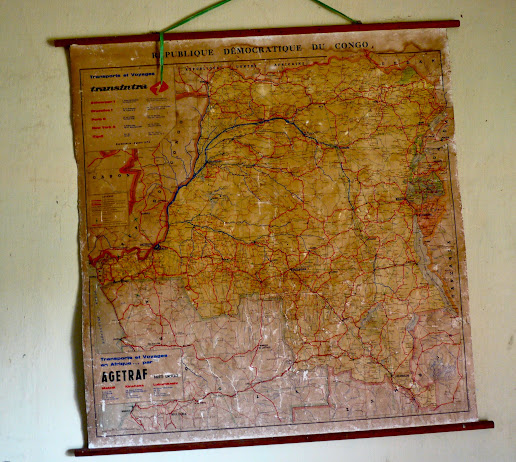
As the rain continued the next morning almost I thought of how much deeper the mud was getting and how long I would be holed up at the mission before I could carry on to reach Luozi, where I would be able to cross the Congo River. I could have cursed the immigration officials for holding me up, but in the end, I’d made it in to DRC, managed to escape a nasty crash with no harm done, and found shelter from the storm just when I needed it, so it was hard to complain that things weren’t going my way.

By mid-day the sun had baked dry the super-slick surface layer of mud so I decided to get moving again. Since I’d only been in the very rural mountains of the country, I had no local currency and so I left Vincent my watch as thanks for his hospitality. Things started out pretty slippy and the road still had some really torn up sections, but none were as bad as I’d seen the previous day. There were still some massive puddles to traverse, but I’d gotten pretty good and making my way through those. As the day wore on and I could distinctly feel the traction returning to the surface beneath my tires by degrees every hour and I rode faster.


|

28 Apr 2014
|
 |
Registered Users
Veteran HUBBer
|
|
Join Date: Nov 2010
Location: Santa Cruz, California
Posts: 316
|
|
|
Shelter in the Congo II
I sped along the ribbon of red earth cutting its way through grassy green hills undulating without end to the horizon. As beautiful as the landscape was, it was apparent that it was substantially altered from its natural state where forests would have covered much of these hills. All around, the hills bore red scars where the earth had been incised and eroded where it was no longer held fast by tangled roots of mighty trees.


I saw a local guy on a motorbike at the side of the road and stopped to see if he was OK. I ended up helping him patch his tube and replace a broken valve stem. By the third time we aired his tube up and found yet another puncture my patience and my tube repair supplies were nearly at an end. This guy was carrying a spare tube with four holes in it!

After an hour by the roadside, I left my motorbike friend with an airtight tube and I motored off, climbing a ridge to catch my first view of the Congo River. It was enormous and majestic. And the last ferry of the day was about one-third of the way to the other side. I’d feared as much while we toiled at the roadside, but I was overdue send some good karma out into the universe anyway.

The next morning, the sky was clear until about 5 minutes after I packed up and headed off to catch the ferry across the Congo River, then rain started to absolutely dump with no sign of stopping, halting the ferry service. I found a schoolhouse roof to shelter beneath and practice my patience while the rain continued to dump in waves for half the day. I was fairly content to sit there, comfortable and dry reading my book until Mother Nature decided that I could be on my way. Eventually she may even let me out of the Congo mud bog.

|

3 May 2014
|
 |
Registered Users
Veteran HUBBer
|
|
Join Date: Nov 2010
Location: Santa Cruz, California
Posts: 316
|
|
A bout of bromantic nostalgia hit after some time on the road..

|

13 May 2014
|
 |
Registered Users
Veteran HUBBer
|
|
Join Date: Nov 2010
Location: Santa Cruz, California
Posts: 316
|
|
|
Chasing Down Rumors in Angola

During the last few years, there have been murmurs of endless barreling lefthanders somewhere in Angola. Two weeks before I’d left California in September 2013, some video footage surfaced on the internet that would seem put to rest any doubt that there are world class waves to be found somewhere out there in the desert. 
I was dressed head to heel in the red earth of the Congo when I finally emerged at the border with Angola and before long I found smooth tarmac guiding me south.

I bush camped my way across the north of Angola. Costs were shocking upon entering Angola even well outside the capital city of Luanda. Food in a restaurant of any kind could generally not be had for less than $20 and even very modest accommodation was $60 at the least, both of which were far beyond my daily budget. So it was that I arrived in Luanda a few days after crossing the border still caked in my Congo mud crust and with Dyna Rae sputtering from some bad gas poured from plastic bottles. Fortunately I’d met some other riders who lived in Luanda and had been following my trip on the web. In fact, their letter of invitation was key to my getting a visa to enter Angola at all. My hosts, Hugo and Alvaro, put a gin and tonic in my hand nearly before I got of the bike upon arriving at Alvaro’s restaurant inside the Villa Aruajo Resort.

The food and drinks kept coming, courtesy of Alvaro, as we had endless discussions about bikes. Alvaro rides a KTM 530 and Hugo just got a Honda XR650R, both of which are much lighter and with about 20 more horsepower than my humble machine. Alvaro is a new addition to the Angolan enduro racing circuit and is currently running in third place for the year. A pang of desire hit as I ripped around the parking lot on Hugo’s barky, aluminum framed XR. It was difficult to keep the front wheel in the ground. Not that I would ever stray from my girl Dyna Rae; she is my rock – steady, reliable, and strong, but it sure is nice to look around sometimes. Alvaro put me up in a room in the air-conditioned office of the restaurant providing me a much-needed reprieve from long days on the road. I washed my clothes, swam in the pool, cleaned Dyna’s filters, and Alvaro even had a pressure washer to give her a good scrubbing. I’d gone from bush camping to luxury accommodation. ADVrider hospitality takes the cake again.

Difficult as it was I finally tore myself from the comfort of Alvaro’s place to head south, I was ready to find some waves again. I found some beautiful spots, but my timing was poor and there was little swell in the water.
 
It’s amazing how within a few days of riding this little machine beneath me, I’ve moved from jungle, to plains and then to desert landscapes. As the air became drier to the south, the lush vegetation melted away and was replaced by rocky outcrops and low shrubs cut by sandy arroyos. If I didn’t know any better, I could easily mistake this landscape for the north end of the Baja peninsula of Mexico.

Riding out to look for surf in the Angolan desert feels a bike like riding to the end of the earth. The landscape is vast and desolate and laid to waste for extraction of resources beneath the surface. Angola is rich in petroleum, iron, and diamonds and is one of the fastest growing economies in the world, but despite its abundant natural resources, output per capita is among the world's lowest and subsistence agriculture provides the main livelihood for 85% of the population. Growth is almost entirely driven by rising oil production. After independence from Portugal in 1975, Angola was ravaged by civil war between 1975 and 2002 and is still rebuilding infrastructure.
 
 
Per my usual routine, after breaking my camp and orienting myself I went for a first exploratory venture looking for surf where the landscape told me I was most likely to find it. Each point of land held enough of a wave to keep me enticed to keep moving forward and see what was breaking on the next one.


It reminded me of another excursion long ago. When I was five years old, my brother and I went on our first adventure. It was up a winding creek bed behind our house. The banks had been steeply incised to create an earthen corridor with tangles of roots spilling out the sides. Our parents had no idea where we were and I knew that we weren’t supposed to be wandering off down a creek, but it was just too much fun to resist. Every time we rounded a bend, I would think to be satisfied just to see what was around the next one. But then there was another one ahead. On we went for hours until our parents were in a panicked state wondering where we were and called the police, landing my brother and I had in plenty of trouble.



The same driving feeling of needing to see what lie just ahead on the next point or section of reef was undeniable as I motored along these tracks all day in the Angolan desert. The tracks crisscrossed in every direction and with no indication of which way to go, the best I could usually do was to try to stay close to the coast. Sometimes that worked well enough and other times it landed my in a dune field that I certainly couldn’t traverse with my bike fully loaded and would be forced to backtrack. In sand, you really have to keep moving to not get stuck. So sometimes you just keep powering ahead in the hope that the loose sand will firm up ahead soon enough. Enthusiasm to see what was around the next bend once again got me in too deep.

Fully loaded and running high tire pressures, I was no match for the dune field that had covered the track. It was an hour of digging in the heat to get myself unstuck. When I finally managed it I made a retreat to the nearby town for a rest and a cold drink. At a street side café a curly haired guy approached smiling and said, “Hey, you must be Gary.” Nuno has been living here away from his home of Portugal for the last eight years and is the only surfer living on this stretch of the Angolan coast. He serves as kind of a de facto host for traveling surfers. Some friends in Luanda had let him know that I was headed this way and it wasn’t hard to track me down in this tiny town. I was more than happy to have someone to show me around the surf and keep me from getting stuck in dune fields. I spent the night sleeping in a hammock on Nuno’s patio and the next morning we surfed a shoulder high lefthander peeling onto a craggy urchin-encrusted reef. I hadn’t had any surf since Point Noire and I was super stoked from my first wave. Nuno was less lucky this day: he broke his board in half and got a foot full of urchins.




The little bit of swell in the water died after that, but there was another swell approaching the following week. I pitched my tent out at as desolate a campsite as I ever have found and waited. There were no trees or any shade whatsoever, so I balanced my board on top of the bike and spent most of the days cowering beneath the shadow that it cast. The fishermen came and went, the wind stirred and calmed, and the tide rose and fell, while I held steady at my little dessert camp.


I spent couple more nights in the hammock at Nuno’s place and we surfed some micro waves at a nearby beach.
 This is going look rad. People are going to think I'm awesome.
This is going look rad. People are going to think I'm awesome. Oops. Maybe not.
Oops. Maybe not.
Then the much-anticipated swell arrived. I loaded Dyna up with water and provisions, got some instructions for where to head from Nuno and headed off into the desert for the week in search of the endless sand bottom point breaks.

After a few wrong turns on the desert tracks and crossing the edges of a few
dunes I found what I was after – craggy black headland with a head high lefthander peeling along the sand. The wave was fast and long, with the section ahead of you always seeming to stand up taller than the one and you were on. It had had you constantly looking for the highest line you could find to get a few pumps and make it to the next section. If you made all of the sections, you earned yourself some burning thigh muscles and a half-mile walk back up the point to do it again.
|

13 May 2014
|
 |
Registered Users
Veteran HUBBer
|
|
Join Date: Nov 2010
Location: Santa Cruz, California
Posts: 316
|
|
|
Chasing Down Rumors in Angola II
|

29 May 2014
|
 |
Registered Users
Veteran HUBBer
|
|
Join Date: Nov 2010
Location: Santa Cruz, California
Posts: 316
|
|
|
Rhinos in the Bush, Skeletons on the Coast

I rode south from Angola desert with my brain still full of memories of racing down watery walls above desert sandbars.  I rode through a gorgeous canyon of metamorphic rocks with walls dropping vertically to the valley floor.

In Angola, the level of development had ticked up a substantial degree from the Congo, and now in Namibia it did so again. Things were remarkably organized. I felt as though I may need to actually stop when someone in a uniform told me to. And things were cheap - with prices a half to a third of those in Angola.
The highway was a corridor tarmac flanked by game parks that seemed to stretch on endlessly. The air temperature was perfect and as the sun went down, I would turn on my music up and float down the road. Some Kudu crowned by their playfully twisting horns appeared at the roadside gingerly prancing about. Total bliss. I’m riding a motorbike through Africa. There are African critters about. I have a surfboard strapped to my motorbike. This is ridiculous.
I just didn’t want to stop riding those nights. It didn’t have to plan very carefully either, as a nice little safari lodge with bush campsites seemed to come up every so often along the road. Sure enough, one of the little lodges appeared ahead in the fading light and I tucked to enjoy a first  in Namibia.

There were some uninvited dinner guests. Or maybe he was just the local lawn mower. At night in my tent at the bush camp I would hear these guys milling about making grunty noises.

I got up at 5AM the next morning to go find some critters. I had no idea that animals got to work so early in Africa. The jackals flanked us.

The lions lurked about stealthily. I swear there’s a lion in this photo. He just happens to look quite a bit like a brown rock.

The zebra got surly.
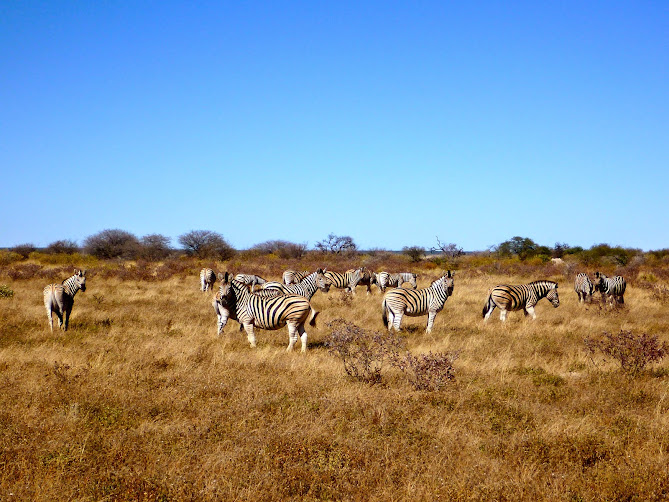
The Rhinos did pretty much went wherever they wanted.

A sea of pink flamingos bobbed about flamboyantly.
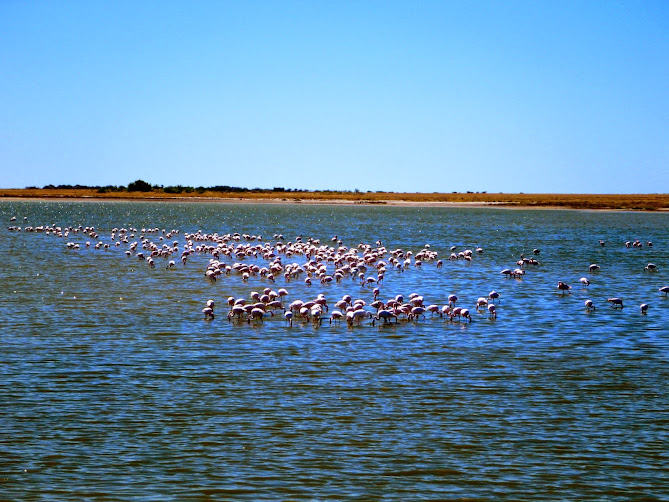
I also spied a dik –dik (super cute little miniature gazelle thing), oryx, springbok, and giraffe. Pretty cool. Maybe there is more to Africa than great surf. Regardless, I rode off the same day to go find some surf. Approaching the coast, the air became very wet and very cold It was the first time I’d been cold since the Atlas Mountains of Morocco, a century ago. I made camp on the Skeleton Coast in frigid temperatures and a thick blanket of fog that completely obscured my view of the ocean. When I crawled out of my tent in the morning, I wasn’t exactly charging into my wetsuit. For months I've dreamed of being cold, but the novelty has worn off quickly. But was here to surf, so I manned up, got on my bike, and blazed forth into the cold misty morning. After about 10 miles, the bike killed. Wonderful.

I took the tank off and started fiddling. Plugs were fine, but I found the fuel filter clogged and cleaned it out. It was so cold that the fuel filter was frozen stiff to the carb inlet and after a couple of yanks I got it loose, but mangled my thumb in the process. My manliness quickly faded. Nothing like the combo of a frigid motorbike ride followed by a good thumb mangling to wake you right up in the morning.
Owwwwwwwaahh.

Don’t even need coffee after that. I pressed on and eventually found a well know chunk of reef with a mellow rippable right and left peeling to either side.
The next day I ventured further afield looking for a wave that has enjoyed recent Youtube fame and is claimed by some to be the best wave in the world on its day: a long, long, dredging, fast, lefthand barrel with a very difficult take-off. That’s a lot of expectation to put on the day as you munch your corn flakes. Today I’m going to try to find and ride the best wave in the world. Better have another cup of coffee. As I rode along sand tracks I felt a bit of Sahara Desert deja vu.

Along the way I met Jim, a bodyboarder/surfer from Durban, South Africa, who was traveling through Namibia with his friend Anna. He flagged me down on the road to ask what on earth I was doing with my surfboard strapped to my motorbike. He happened to be in search of exactly the same wave that I was, so we headed off with Jim and Anna in their 4x4 as I led the way. I rode through a narrow causeway between miles of salt farms, or whatever places are called that extract salt from seawater.

The salt crystals made some fantastical looking dendritic branches into the water.

When we got into the vicinity of where I thought the wave should be, Jim and I tried to decide which way to head. We hemed and hawed about a number of different spots. Could this be it?

When we finally came upon it, it was strikingly obvious. Ah, there it is.

We hopped around to warm up as we turned our wetsuits right-side-out and steeled ourselves to jump into the frigid looking water with a bone crunching little barrel grinding through it.

Jim got some nice little tubes on the bodyboard.

I mostly got stuck in the lip and pitched ass over tea kettle.

Once in awhile I made the drop and stuffed myself into a little backside tube. By the second day of surfing here, I even made it out of one or two of them.

The surf was good, but nothing legendary and we had as much fun exploring as we did riding waves. Even the best wave in the world has its off days and we had a swell running that was angled a bit to southerly for this spot to really do its thing.
While usually I don’t like to stray too far from the coast, I have to say that after the swell subsided I was happy to leave the drippy wet weather for the inland desert. I crawled out from underneath the fog bank to find another gorgeous desert landscape stretched before me as I headed south.


Soon after leaving the coast, a young blonde guy in a land cruiser flagged me down on the highway. It was Jonah! Remember this guy?
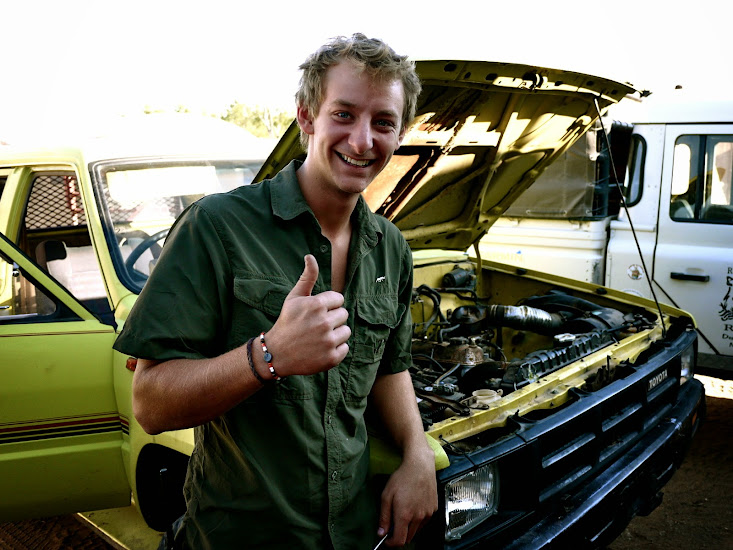
He and his uncle Chris had helped push me out of the Senegal River and Jonah and I had ridden 2-up on my bike from Dakar to the Gambia. Since then he had come to Namibia to work for a desert resort owned by some family friends. Quite a turn of chance to run into each other on the street half a continent from our last encounter! Jonah invited me to come stay at the resort free of charge. This place was a true Oasis in the middle of a completely barren landscape and had the coolest pool I’d ever seen.
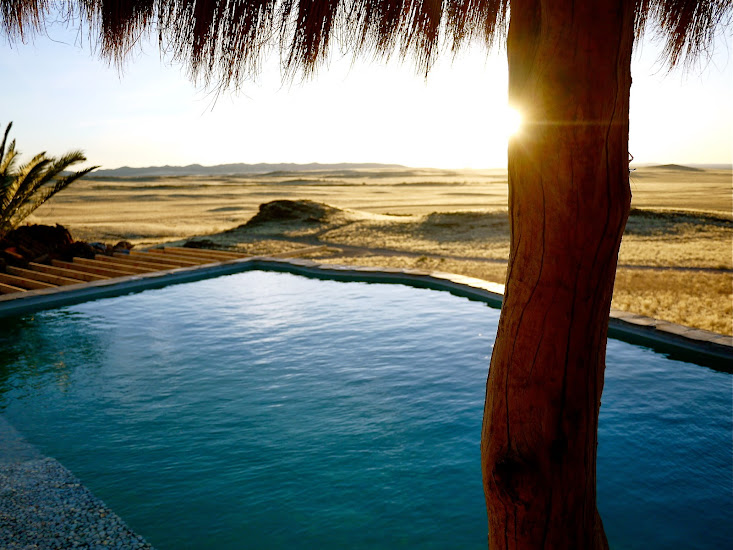
I slept in a wonderfully comfortable bed for a change and was happy not to cuddle up with some of the dessert critters that prowled about.

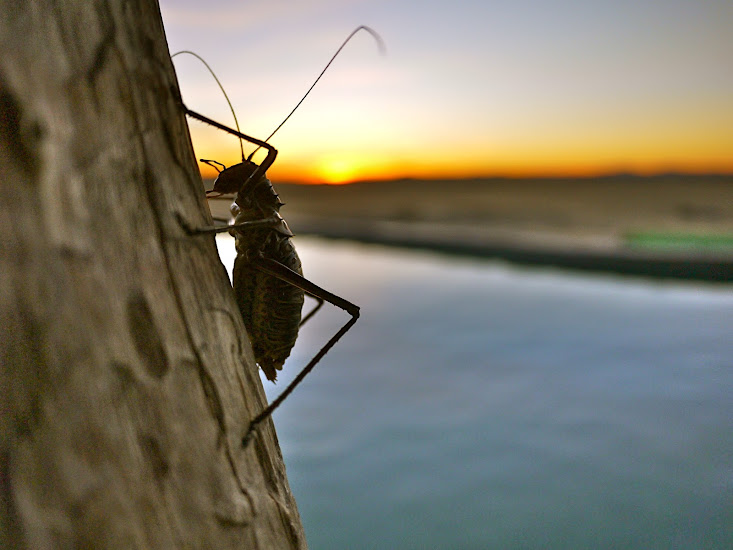
We had a commanding view of the valley floor from the rocky outcrop the resort was built upon, making for a gorgeous desert sunset as the shadows of the hills stretched long below us.

The morning brought another long day on dusty roads with gorgeous vistas. The gravel roads were perfect – better quality than the tarmac roads in most of Africa! Again riding adjacent to game parks, Oryx and Springbok matched pace with me running alongside or right on the road. Some Springbok stayed with me for several miles running at nearly 40 mph. One poor unfortunate one darted for the barbed wire fence that ran parallel to the road, leaped, and caught one of his horns in the wire. The poor little fella's body wipped over the fence snapping his neck. I stopped the bike and walked up to him as his eyes gaped wide and a trickle of blood ran from his nose and his mouth. These animals have the pretties faces. It was a sad interlude to the day, but overall and all I was having a fantastic time riding my bike around in Namibia and hardly wanted it to end. Only a few hundred miles of South African coast lay ahead before reaching the bottom of Africa.

|

9 Jun 2014
|
 |
Registered Users
Veteran HUBBer
|
|
Join Date: Nov 2010
Location: Santa Cruz, California
Posts: 316
|
|
|
Case Closed on Kakonso
 Update as of 6/9/2014 : Kakonso Village now has clean water to drink
Update as of 6/9/2014 : Kakonso Village now has clean water to drink
 Well, no one said it would be easy. Unfortunately the drilling team found some difficulty, drilling 5 bore holes before finally hitting water.


The sixth hole that they dug hit water but a very low flow rate and contaminated with clay. Check it out:

The equipment for the well that you see above was removed, since the well wasn't deemed viable and Coco got most of the money refunded form the drilling group. Fortunately another group with a different drilling technique had better success. Here is the other well setup, when it was nearly ready to go.

From Coco's last report, this well is now perfectly functional and Kakonsoso village has clean clear water to drink. Yahoo!  We'll probably have some more updates from Coco, but I think we can call it cased closed on Kakonso for now. Again, so much thanks to everyone for all of your help solving this problem. Please stay tuned for the next project....
|

24 Jun 2014
|
 |
Registered Users
Veteran HUBBer
|
|
Join Date: Nov 2010
Location: Santa Cruz, California
Posts: 316
|
|
|
The Bottom of Africa

Sitting in a comfy Cape Town backpacker hostel where I’d pitched my tent for the week, I began to feel nostalgic for places now many miles in the rear view mirror.  I walked into a supermarket and bought everything that I could possibly want to eat. I went into a hardware store and found any tool I could need. I spent half an hour in a motorbike shop gawking at shelves of tires and parts. On the way to all of these places, drivers courteously allowed me to occupy an entire lane of traffic without shoving me over to the shoulder. A wonderful little machine washed the dust from my clothes for me. Much of the inconvenience and uncertainty of my days has faded away. The things that I once complained to myself about are no longer a problem, and in an odd irrational way I miss them. They were the sour that made some of those sweetest moments possible when sliding on a wave or flying through the dirt or meeting the kindness of a stranger on a dark road in the rain. I’m going to do my best to remember this feeling in the months ahead when I’m eating lots of rice with fishy sauce for every meal and trying to find a clear spot in the jungle to pitch my tent.
Namibia is long. I rode and rode and rode and there was always still some Namibia up ahead. Crossing borders has become astonishingly easy: no visas, no hassle, just present the passport for a stamp and on my way. I made a camp just across the border in South Africa and found a storm waiting to meet me during my ride the next day. I hit the coast about 100 miles north of Cape Town with huge storm surf furiously pounding on the shore. My target was a classic lefthand reefbreak, but with the chaotic mess that the ocean had become, I couldn’t even tell where the spot was. There was a big campsite right on the beach, but with the storm raging, I was the only person staying there. The next morning, the storm had subsided, the surf cleaned up and as I sipped my morning coffee I began to see some defined lines forming up on the reef.

As the tide rose, a couple of local surfers appeared in the line-up and I suited up to join them. Getting out involved slogging your way through thick stands of bull kelp with their holdfasts attached to the shallower parts of the reef. Trying to dodge the kelp paddling into a wave made it feel like surfing back home in Northern California. I surfed fantastic head-high walls in light offshore winds with four of the local riders that morning. The inside pitched over a shallow chunk of reef and I got a few quick, super easy and nearly dry little tubes through that section. By the afternoon, everyone was finished and after running back to my campsite to scarf two peanut butter and jelly sandwiches, I had it all to myself for the rest of the day which was just too much fun. The campsite had endless hot showers that made coming in from the surf a total joy.

A motorcycle trip: possibly the only time in your life when you will store your olive oil next to your chain lube.

I went to sleep excited for what I’d find the next day, but woke up to another stormy mess in the ocean showed no signs of letting up. I’d caught a lucky break between storms on that first day and after 4 more days of waiting in the wet, my patience gave out and it was time to head to Cape Town.
I laughed to myself when I got under way that after all this way, it was only a few hours ride ahead to Cape Town. I was glad for it as well, given the state of my bike. The rear tire was absolutely done, the front brake pads had only the smallest fraction of a millimeter left to burn, and the rear brake pads were on the metal. The rear tire was starting to show the steel belting in one spot, which can be dangerous, so as silly as it seems I took the only preventative measure I could think of. It is not a good sign when you start putting tube patches on the outside of your tire.

I removed the rear pads and dug my spare ones out to find that I’d carried the wrong brake pads all the way from London. Now I had no pads in the caliper at all, so I had to take care not to hit my rear brake. The rain started in again the morning I headed off – less than ideal conditions to be short on braking power. No problem, I’ll ride slowly. It’s only a hundred and twenty miles, perfect tarmac the whole way.
Unfortunately, the road leading away from the coast was under construction and the rain made it super slippy. With poor traction it becomes reflexive to use your rear brake, since using the front brake can easily cause the front wheel to wash out when turning, resulting in a rapid face plant to the dirt. It took total focus not to touch my rear brake for that stretch, but eventually the tarmac returned and I sped along to Cape Town.
In Cape Town I found the great guys at Outriders moto shop to help me sort out my bike. How luxurious it felt to watch someone else wrestle a tire on to my rim while I stood by drinking a  with the guys in the garage. Dyna Rae got some new rubber on the rear wheel and fresh set of brake pads front and rear. After tucking into the backpackers in Cape Town, I found a place to change her oil, clean the fuel and air filters, check the valves, lube the cables, replace the headlight bulb, and redo some electrical connections. With a little TLC, she was running smooth and feeling strong again.

After a couple days in Cape Town, I met up with my good friend Mike from California who is to join me riding the stretch from Cape Town to Tanzania. Mike is a dirt rider and a surfer who was with us on the Circle the West journey on his DR350 the summer before I’d left the US. While we set to finding Mike a bike to ride and figuring out logistics, we had a look around Cape Town. For some reason we decided to hike to the top of Table Mountain on a day that the top was completely shrouded in a bank of fog - the ‘tablecloth’ flowed down the slopes and over us as we ascended into the mist. One of the wonders of the natural world and we decided to climb it when we could hardly see anything. Very well done, American tourists.


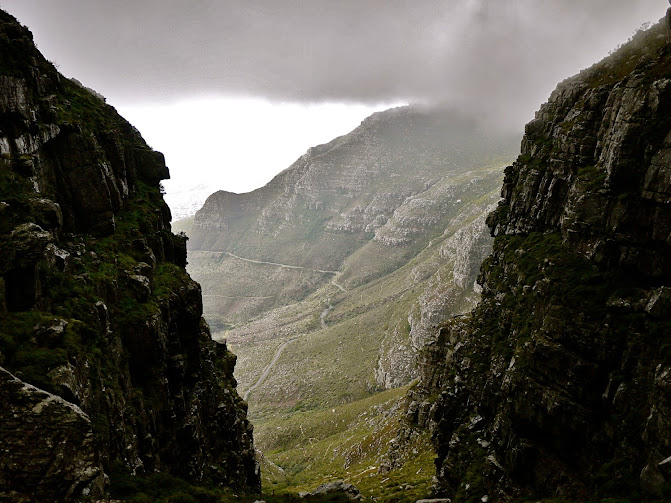
In Swakopmund, Namibia I’d met a Samantha, a UK doctor living in Cape Town, and also a surfer. Mike and I met up with Sam and her friend Carla for a few days of super fun longboarding at the south facing beaches of the Cape Town where the wind always seems to blow offshore. The water was bone chilling, but we were a hardy little surf crew and quickly had steaming chai lattes from in hand upon exiting the water.

Sam is an adventurous type and I had to stop her from making off with my bike.

Unfortunately the registration system changed this year in South Africa, requiring up to a month wait for foreigners to acquire something called a Traffic Register Number to register a vehicle in their own name. They wouldn’t even let Mike submit the application without proof of residence in Cape Town in the form of a bank statement or a power bill. Even a letter from the management of the backpacker place stating that we lived there wouldn’t suffice. So that left us running around to banks trying to open an account. This was turning into a major fandango. The only alternative was to have a bike registered under someone else's name, but that could only add trouble to border crossings.
We enlisted some help from a guy named Alex who knew his way around the traffic departments in Cape Town via his business called Drive Africa. By using his address and contacts in the traffic department he saved us weeks of time for getting on the road. In all it took us about a week and a half get a bike sorted and on the road. Mike went with the low budget option of a Chinese manufactured 250cc bike. The thing is obviously of dubious quality, with plenty of unnecessary colorful plastic bits bolted here and there, but the cost was less than half of its Japanese counterpart. Never mind the less than 6 inches of dodgy feeling suspension travel, it’s got radical off-road styling.


The Chinese Dream only broke down twice on the way out of Cape Town. The first time, the battery wasn’t charging properly due to a connection that had come loose and the second time, a faulty retainer clip had allowed the exhaust to burn a hole through the rear brake line creating a little brake fluid fountain every time he used it. Half the adventure may just be keeping this thing going. The upside is that that most of Africa is riding around on Chinese made bikes like this anyway, so if we can’t fix it, surely someone else can. This model from Bashan Motors is called the Xplode. We really hope the Xplode doesn’t explode.

The cows gave moos of approval for Chinese Dream

and rainbows appeared overhead. I think we’re going to be OK.

From Cape Town we rode along the coast to the southern tip of Africa at Cape Agulhas that marks the boundary between the Atlantic and Indian oceans. Warm turquoise waters and Indian Ocean swells lay ahead. This was it, the bottom of the continent, the point I’d been aiming towards for eight and a half months; riding through deserts, mountains, and jungles, across rivers, mud bogs, and dune fields. It seems like ages ago that I collected my bike in a London shipyard warehouse and pointed her south towards the straight of Gibraltar. I can hardly believe that I’m about to turn around and ride back up the other side of Africa.

|

12 Jul 2014
|
 |
Registered Users
Veteran HUBBer
|
|
Join Date: Nov 2010
Location: Santa Cruz, California
Posts: 316
|
|
|
Cycles South

We reached Cape Agulhas at the leading edge of a storm and turned north to begin the journey back to the top of Africa along the east Coast of the continent.  With my friend Mike from California having joined me in Cape Town, I would have company on the road all the way to Tanzania. In true feral surf tour fashion, we camped rough when required.

The first stop on this surf tour was a tiny little pocket bay that hosts a rocky righthand pointbreak at one end. The swell cranked up, creating a good size wave with a messy jacking take-off in a field of rock boils and a short wall that allowed a few turns before it moved near to a deep water channel that turned the wave into a giant pregnant musher. She was pushing 8 months. After riding lefts most of the way through West Africa, I was just happy to do a bottom turn facing the wave.

At the peak of the swell it was a bit of tricky business to launch off the rocks without getting bounced around like a pinball.

This is winter in South Africa, prime time for big swells, and so far we haven’t been disappointed. After the swell subsided we got on the road knowing that another one was stacked up right behind it and we knew right where we wanted to be when it arrived. Jefferey’s Bay is a place that looms large in the imagination of surfers the world round. Arguably the world’s best righthand pointbreak, it ropes in swell energy from storms in the roaring 40’s and turns it into a freak of nature: a kilometer long stretch of coast with perfect reeling walls of water for surfers to race along. The black volcanic reef is oriented such that it holds the sand delivered from up-current securely in place to create the perfectly the groomed walls that this place is famous for. It has been surfed since the mid-1960’s and since then has become a Mecca-like pilgrimage for traveling surfers, in the same league with treks to Hawaii and Indonesia.

The waves at J-bay lend themselves to high-line speed runs, deep bottom turns, arcing carves, and midface snaps in the pocket. The star of the show is the chunk of reef called Supertubes, where multiple tube sections pitch out as you speed along. Its super duper.

You can ride a barrel with your buddy right behind you riding a barrel.

Sometimes when you pull into a tube a rainbow appears overhead with unicorns flying around and magical flowers sprout on the beach.

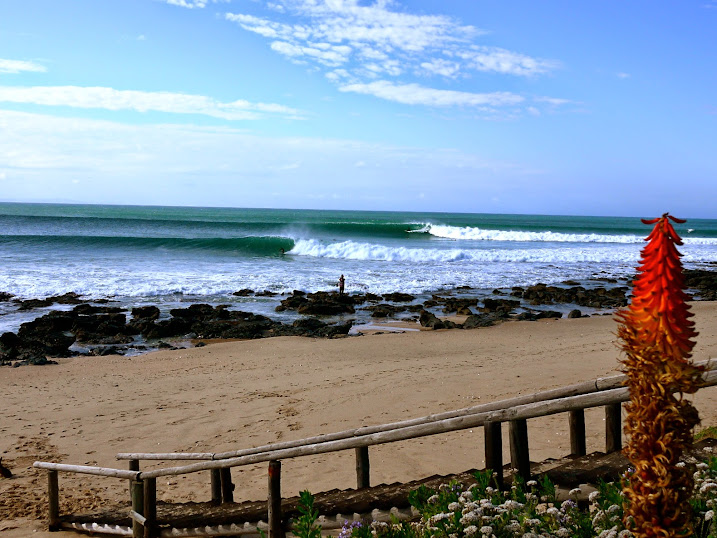
Unfortunately unicorns cannot be photographed.
To my taste, Supers is just about the perfect wave to ride with its perfectly groomed walls and tube sections. There are even nice little keyhole channels of deep water in the reef to help you get in and out of the break. A down-side it is that sharks prowl the lineup from time to time. South Africa has got to be the sharkiest place on the planet to be a surfer. Nearly every South African surfer that you meet has a shark story of one sort or another. The last time I was here, surfing a place called Nahoon Reef, a week after I’d left a surfer was filmed being grabbed by a shark on the arm just as he was taking off on a wave. The eerie footage of the shark silhouetted in the wall of the wave as he makes for the surfer became a hit on Youtube. This time around, the day before we arrived in J-bay, a great white briefly appeared and scared everyone out of the water for a few hours. I’ll be happy to get my waves in South Africa without a shark story of my own.
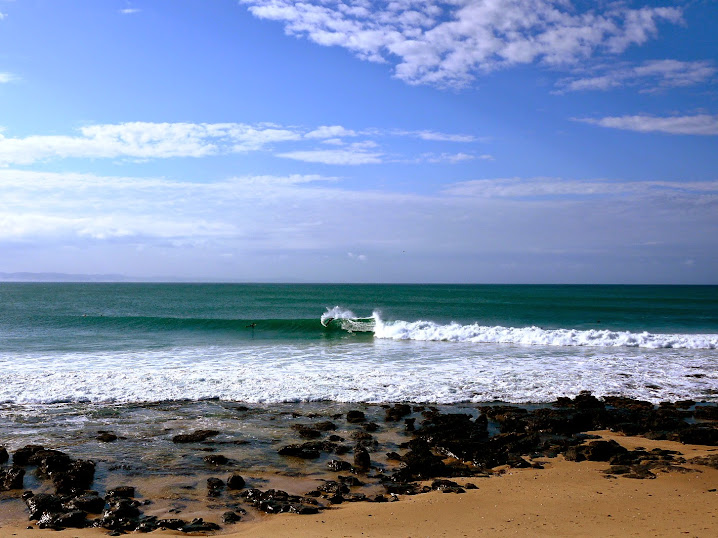
The day that we arrived it was too small to surf Supers, but Mike and I rode some really fun waves further down the point, where the waves break a bit easier and slower. The next morning the swell cranked up and we rolled out of our beds to find offshore winds and Supers doing its thing at about 6 foot. I scrambled into the lineup and began to find my feet, remembering what this wave is like. The last time I rode it was 14 years ago when I was a rambling surfer hopping on and off of buses in Africa. Some of the surroundings have changed since then, but I was happy to find that the wave hasn’t changed one bit. A photographer called Ross Turner generously shared some of his fantastic shots from the week, which you’ll see throughout this post.

The crowd was mellow and per local parlance, ‘the waves were cooking bru’. It always takes me a while to get used to surfing a wave like this. You don’t have to be super quick to surf it well, but you do have to be smooth and read the wave correctly. On my second wave, I did a fast carving top turn then layed into a deep bottom turn, waiting for the next barrel section to stand up in front of me. Here it comes, get back up on the face and get on the gas. I did a half snap two thirds of the way up the wave face as the lip started to pitch above my head and I held steady in the pocket. The lip charged ahead as I looked through the almond shaped window of the tube. Stay high, drive through to the opening. I was buffeted by a few chunks of the lip collapsing on me I watched the opening recede away from me and I knew that I wasn’t going to make this one. I didn’t care very much. It felt fantastic anyway.
I surfed all day in light offshore winds and a sparse crowd and managed a few good carves, snaps and tube rides. By my own personal standards (ego-cushioningly low), I was ripping. Surfing J-bay is all about finding your line, a path that suits both the wave and rider. I suppose that all of surfing is this way, its just that the waves in J-bay make it strikingly obvious. I believe that it was the former world champion and J-bay resident Derek Hynd who once commented that Surpertubes isn’t actually a hard wave to ride, but it is a hard wave to ride well. It feels like a surfing analog to Michelangelo’s perspective on sculpture: the figure already exits within the marble; you just have to remove the unnecessary bits. There are endless possible lines on such a perfect watery canvas and you just have to find the one you want to draw and leave out anything that doesn’t add to the ride.

People were stoked.
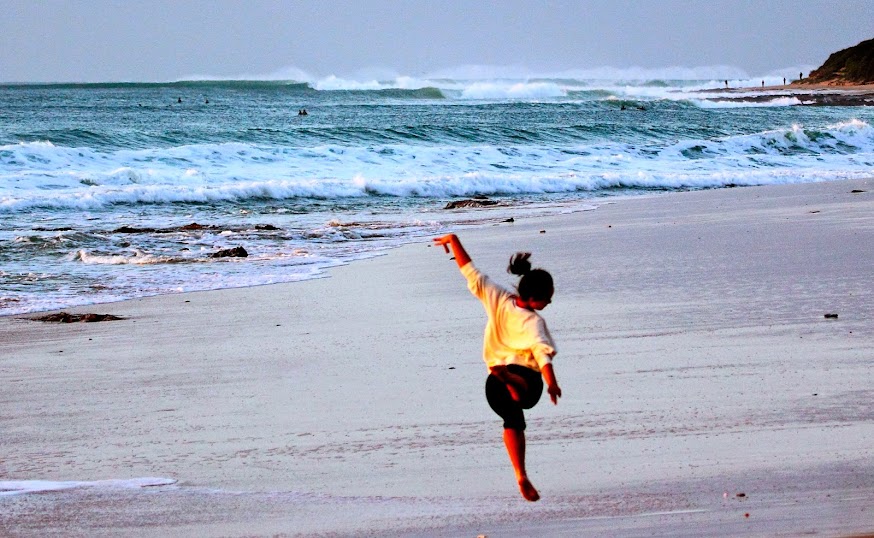 photo by Ross TurnerAs the storm grew nearer, the swell boosted and the wind strengthened. It rained during the night and in the morning the waves were 8-10 feet and with a nasty strong cross-offshore wind. The ‘devil wind’ they call it. The wind made getting into waves difficult and created warbles in the lip that would cause unmakable sections to throw over here and there. Picking the right one was key. Grant ‘Twiggy’ Baker was killing it. The guy shows up in my hometown to win the Mavericks big wave contest and then shows us how it's done at Supers. Legend.
 photo by Ross Turner 
We watched for most of the morning, hoping that the wind would mellow out. When it didn’t, it was time to charge out anyway. I stood at the keyhole channel at the top of Supers for 20 minutes behind a local guy holding a seven-foot gun waiting for some sort of break in the sets, but there was hardly anything. My rationale was that this guy knows the place better than I do, when he goes, I’ll go. But he never did. So I jumped in at a moment when it looked slightly less punishing. The current swept me way down the point before I made it out the back, making for a long paddle back to the top of Supers. By the time it was starting to get dark, I’d only caught one wave. Something manageable looking marched towards me and I swung around. The offshore had me hung up in the lip, but I was already committed. I free fell midway down the face and got whipped over by the lip giving my neck a good wrenching. After that sad display, all I felt like doing was drifting down towards the point and finding something to ride in before it was dark

The next day the storm had moved eastward away from the coast and the swell and wind mellowed out leaving us with 2 more days of perfect 6-foot waves to ride. I earned some redemption from my flogging the previous day snagging a couple of the big sets, finding a few tube rides and laying down some decent carves.
 photo by Ross TurnerHad enough of the epic lineup and tube photos? One more.

Ok, just one more.
 photo by Ross TurnerAfter a final surf at Supers it was time to pack up and leave the legend behind. Our timing couldn’t have been perfect really as the Billabong Pro World Championship Tour (WCT) was about to descend onto J-bay turning the shoreline into a circus and filling the water with the best surfers in the world. While it would have been a blast to watch the show, given the choice I’ll take our 5 days of relatively uncrowded waves any day. I would spend the next week feeling my stiff neck that resulted from my flogging on the big day and replaying a number rides over again in my head.
 photo by Ross TurnerFrom J-bay, Mike and I rode into the rolling grassy hills dotted with traditional roundel huts of the Transkei Region where life moves slowly and people live simply. We wound along a strip of rough asphalt approaching the Wild Coast of South Africa where we passed one hilltop village after another with no shortage of kids waving and smiling as we rode past.


We ripped down rocky dirt tracks that paralleled the coast jutting out towards the ocean and then arcing back inland to traverse a river valley.

We found a number of pocket bays to surf with plenty of size but decidedly mediocre shape. It was the landscape and people that that captivated us here more than anything else. We probably had the best campsites of anywhere yet in South Africa, perched atop trimmed grassy hills and looking right down on the surf.
 South of the industrial center of Durban, I finally got to take the wetsuit off again to ride an easy, rippable righthander breaking along a small rocky headland. I surfed all day long in crystal blue water and never even got cold. We found some punchy quick waves at Balito Bay, which, like J-bay was also gearing up for contest season. A World Qualifying Series (WQS) prime event (highest level event below the WCT) was starting in 2 days time, and the lineup was already full of wave hungry competitors.

Mike and I have had a blast ripping through South Africa surfing. The waves have been truly fantastic, but I think we’re both ready to leave behind the perfect roads, comfortable accommodation, and general high level of civilization found here. It’s time to head north to the wild spaces of the continent where everything feels a bit less predictable.
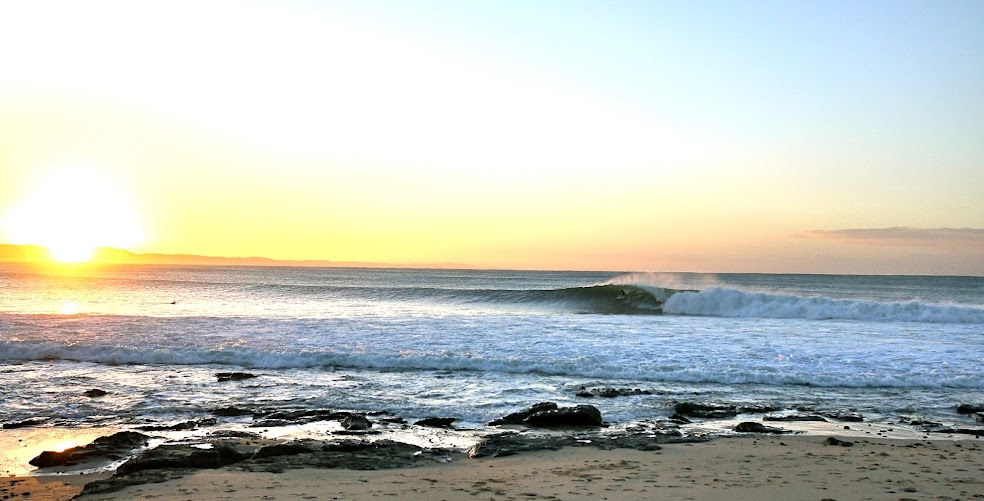
|

13 Jul 2014
|
|
Registered Users
Veteran HUBBer
|
|
Join Date: Feb 2012
Posts: 836
|
|
Thank you for sharing your trip! I'm always happy if I see a new posting here!
Well written, nice pictures - definitively the best current trip to follow at the web 
Safe travels,
Surfy
|
|
Currently Active Users Viewing This Thread: 4 (0 Registered Users and/or Members and 4 guests)
|
|
|
 Posting Rules
Posting Rules
|
You may not post new threads
You may not post replies
You may not post attachments
You may not edit your posts
HTML code is Off
|
|
|
|

Check the RAW segments; Grant, your HU host is on every month!
Episodes below to listen to while you, err, pretend to do something or other...

2020 Edition of Chris Scott's Adventure Motorcycling Handbook.
"Ultimate global guide for red-blooded bikers planning overseas exploration. Covers choice & preparation of best bike, shipping overseas, baggage design, riding techniques, travel health, visas, documentation, safety and useful addresses." Recommended. (Grant)

Led by special operations veterans, Stanford Medicine affiliated physicians, paramedics and other travel experts, Ripcord is perfect for adventure seekers, climbers, skiers, sports enthusiasts, hunters, international travelers, humanitarian efforts, expeditions and more.
Ripcord Rescue Travel Insurance™ combines into a single integrated program the best evacuation and rescue with the premier travel insurance coverages designed for adventurers and travel is covered on motorcycles of all sizes.
(ONLY US RESIDENTS and currently has a limit of 60 days.)
Ripcord Evacuation Insurance is available for ALL nationalities.
What others say about HU...
"This site is the BIBLE for international bike travelers." Greg, Australia
"Thank you! The web site, The travels, The insight, The inspiration, Everything, just thanks." Colin, UK
"My friend and I are planning a trip from Singapore to England... We found (the HU) site invaluable as an aid to planning and have based a lot of our purchases (bikes, riding gear, etc.) on what we have learned from this site." Phil, Australia
"I for one always had an adventurous spirit, but you and Susan lit the fire for my trip and I'll be forever grateful for what you two do to inspire others to just do it." Brent, USA
"Your website is a mecca of valuable information and the (video) series is informative, entertaining, and inspiring!" Jennifer, Canada
"Your worldwide organisation and events are the Go To places to for all serious touring and aspiring touring bikers." Trevor, South Africa
"This is the answer to all my questions." Haydn, Australia
"Keep going the excellent work you are doing for Horizons Unlimited - I love it!" Thomas, Germany
Lots more comments here!

Every book a diary
Every chapter a day
Every day a journey
Refreshingly honest and compelling tales: the hights and lows of a life on the road. Solo, unsupported, budget journeys of discovery.
Authentic, engaging and evocative travel memoirs, overland, around the world and through life.
All 8 books available from the author or as eBooks and audio books
Back Road Map Books and Backroad GPS Maps for all of Canada - a must have!
New to Horizons Unlimited?
New to motorcycle travelling? New to the HU site? Confused? Too many options? It's really very simple - just 4 easy steps!
Horizons Unlimited was founded in 1997 by Grant and Susan Johnson following their journey around the world on a BMW R80G/S.
 Read more about Grant & Susan's story
Read more about Grant & Susan's story
Membership - help keep us going!
Horizons Unlimited is not a big multi-national company, just two people who love motorcycle travel and have grown what started as a hobby in 1997 into a full time job (usually 8-10 hours per day and 7 days a week) and a labour of love. To keep it going and a roof over our heads, we run events all over the world with the help of volunteers; we sell inspirational and informative DVDs; we have a few selected advertisers; and we make a small amount from memberships.
You don't have to be a Member to come to an HU meeting, access the website, or ask questions on the HUBB. What you get for your membership contribution is our sincere gratitude, good karma and knowing that you're helping to keep the motorcycle travel dream alive. Contributing Members and Gold Members do get additional features on the HUBB. Here's a list of all the Member benefits on the HUBB.
|
|
|

















 134Likes
134Likes
 It occurred to me that the reason motorbikes generally didn’t follow any rules in Accra was because there were so few of them cruising the streets. In Lome, with so many bikes about, it would create a lot more chaos if everyone were blowing through red lights. There was something very comforting about being back in a sea of motorbikes – surrounded by my African two wheeled brethren!
It occurred to me that the reason motorbikes generally didn’t follow any rules in Accra was because there were so few of them cruising the streets. In Lome, with so many bikes about, it would create a lot more chaos if everyone were blowing through red lights. There was something very comforting about being back in a sea of motorbikes – surrounded by my African two wheeled brethren!






 waiting for me. Then the police showed up.
waiting for me. Then the police showed up.











 We'll probably have some more updates from Coco, but I think we can call it cased closed on Kakonso for now. Again, so much thanks to everyone for all of your help solving this problem. Please stay tuned for the next project....
We'll probably have some more updates from Coco, but I think we can call it cased closed on Kakonso for now. Again, so much thanks to everyone for all of your help solving this problem. Please stay tuned for the next project....


 Linear Mode
Linear Mode




